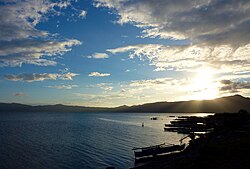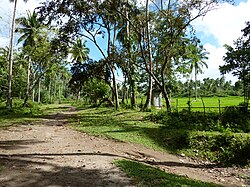Surigao del Norte
| Basic data | |
|---|---|
| Region : | Caraga |
| Capital : | Surigao City |
| Population : | 485.088 August 1, 2015 census
|
| Population density : | 246 inhabitants per km² |
| Area : | 1,972.93 km² |
| PSGC : | 166700000 |
| Governor : | Sol Forcadilla Matugas |
| structure | |
| - Highly urbanized cities | |
| - provincial cities | 1 |
| - municipalities | 20th |
| - Barangays | 335 |
| - electoral districts | 2 |
| Location of the province in the Philippines | |

|
|
Coordinates: 9 ° 45 ' N , 125 ° 33' E
Surigao del Norte is a province in the northeast of the Philippine island of Mindanao . Politically, it belongs to the Caraga district (Region XIII). The capital of the province is Surigao City , the governor is Sol Forcadilla Matugas.
geography
Surigao del Norte is one of the northernmost provinces of Mindanao and the most important transit station to the islands of the Visayas . It includes two large islands, Siargao and Bucas Grande , which are located in the Philippine Sea . Other smaller islands in the province are Gaboc Channel and Nonoc, as well as Awasan Bay, Hanigad and Hikdop.
On the mainland side, Surigao del Norte borders the provinces of Agusan del Norte and Surigao del Sur in the south . In the north is the island province of Dinagat Islands , while in the east the Pacific and in the west the historic Strait of Surigao stretches.
Numerous ferries cross the Surigao Strait between Mindanao and the Islands of Leyte to carry vehicles, goods and people between Liloan in Southern Leyte and Surigao City .
Much of the coastline is overgrown with mangroves. These trees, which prefer salt water, cover an area of 175 km² along the coast of the mainland and the island of Siargao.
The province has many caves and underwater tunnels on its islands. Some are half flooded most of the time and can only be entered at low tide, such as Suhoton Cave on Bucas Grande Island. The largest islands are mountainous and rich in minerals. Nonoc Island, for example, has one of the world's largest deposits of nickel . On the other hand, some of the smaller islets, such as those at Del Carmen on Siargao Island, are nothing more than a pile of rocks rising from the water and crowned by bushes and coconut palms. In addition, there are well-worth seeing springs, lagoons, waterfalls, mangrove forests, swamps and whirlpools on the mainland, which are much more interesting for tourism.
The highest mountains are Mt. Legaspi with a peak height of 1,170 m on the border with Surigao del Sur, followed by Mt. Agudo, with a height of 1,018 m and Mt. Satellite, which towers above sea level by 1,016 m. The northern part of Lake Mainit is also located in the provincial area .
Near Siargao Island is the deepest point of the Philippines Trench , the Galatheatief , the bottom of which is 10,540 m below the sea surface.
The total area of the province is 2,740 km², which corresponds to 9.67% of the total area of North Mindanao.
Demographics and language
Surigao del Norte has a population of 374,465 people according to the 2000 census. It ranks 27th among the provinces with the lowest population in the country's demographic statistics. The average population density is 193.3 inhabitants per km², which makes it 47th in these statistics.
Surigao is home to the Mamanwa ethnic group. In addition, the majority of the inhabitants of the province are of Austronesian origin, with a significant number of Chinese , Japanese and Arabic roots. In addition, Europeans and Americans have also influenced the culture of this region.
About 95% of the population use Surigaonon as their main language. In addition, also influences are Cebuano and Boholano with Tausug find -Akzenten. A minority use the languages Waray-Waray and Tagalog , although most of the residents can also communicate in English due to their schooling .
The dominant religion is Roman Catholic . Other denominations , such as the Independent Filipino Church , whose headquarters are on Dinagat Island, and various prosthetic denominations are also based here.
economy
Surigao del Norte lives from fishing, agriculture, tourism and its natural resources. The fishing grounds of the Philippine Sea and the Pacific provide yellowfin tuna , Indo-Pacific blue marlin , groupers , lobsters, and many other saltwater fish species. There is also a brackish water area totaling 40 km² and a fresh water area totaling 87 km² for breeding and catching freshwater species.
The islands and small islets are surrounded by the most impressive coral reefs. In addition, the mangrove forests, the white sandy beaches, the mountain lakes, the rock formations and the underwater caves have enormous tourist potential. The province is already being visited by many foreign and domestic holidaymakers who visit the islands and coasts of Surigao for diving, fishing and surfing.
Surigao del Norte is rich in natural resources, especially metallic and mineral resources. In addition to gold , chromite and nickel , it is mainly silicate and limestone that is mined by the six large mining companies located in the province. The "Red Mountains" in the south of the province are the largest iron ore deposits in the world. The mineral is extracted on a large scale by means of open-cast mining, transported directly to the coast on specially constructed slopes and then shipped there.
Agricultural products include abacá , citronella , coconut , bananas , pineapple and jackfruit .
Administrative division
Surigao del Norte is divided into 20 independently administered municipalities and one city. The communities in turn are subdivided into a total of 335 barangays (districts).
The province is divided into two congressional districts.
city
Communities
|
history
Origin of name
There are various possible origins for the origin of the name. The name probably comes from the Spanish word Surgir , which can be translated as fast water or current .
history
The Mananwas, the ethnic group that is ethically based in Surigao, like the Manobos, were converted to Christianity in the early period of the Spanish conquest. A compilation of grave goods from ancient archaeological excavations, such as jugs and ancient Chinese kitchen utensils unearthed in Panhutungan, documents this prehistoric period in the province. The items can now be admired at the Surigaonon Heritage Mini-Museum in Surigao City .
In 1538 the eastern coast of Mindanao, in which the present-day province of Surigao del Norte is also located, was visited by the Portuguese explorer Francisco de Castro , who found the area populated by the Caraga ethnic group, whose origin according to today's knowledge is the Visayas lies.
Five years later, a Spaniard named Ruy López de Villalobos landed in this area. Its navigator, Bernardo de la Torre, named the place "Cesaria Caroli" in honor of the ruling monarch Carlos V. However, the name did not catch on because the Spaniards named the area "Caraga" after a local chief.
From 1597 Jesuit missionaries tried to evangelize the people of Butuan (later the province of Agusan) and Caraga (later the province of Surigao), which turned out to be difficult and only had temporary success. They were replaced in 1622 by the Augustinians , who founded parishes in 1642 in Tandag and Bislig . The Augustinian orders were present in the area until 1875, when they were replaced by secular priests. Between 1893 and 1908, Benedictine monks took over missionary work in this region.
On May 23, 1942, Japanese forces under the command of Colonel Yoshie Butuan Caraga and the town of Surigao reached. On May 28, 1942, the village was completely under the control of the Japanese forces of Lt. Ichichara.
Liberation from the Japanese occupation began on September 9, 1944. American fighter planes began the campaign early in the morning by bombing Surigao. This was followed by an attack on all Japanese ships that were moored in the city's shipyard to transport fresh troops and materials to their troops in Leyte. No ship was buoyant after the attack. By April 12, 1945 , the Japanese had been completely defeated and peace returned to the province.
Political Chronicle
The original district of Caraga was established in 1609 and included what are now the provinces of Surigao del Norte, Surigao del Sur , the northern part of Davao Oriental and the eastern Misamis Oriental .
In 1860 Mindanao was divided into six districts by the Spanish administration. Surigao and Agusan, which included the territory between Butuan and Caraga Bay, were combined to form the third district, which was also called the Eastern District . In 1870 he was named "Distrito de Surigao"
Towards the end of Spanish rule around 1897, the two present-day Agusan provinces were reorganized into a single political-military command of "Butuan", which initially included Surigao in its administrative responsibility. On May 15, 1901 , the American military administration established a civil government in Surigao Province with Prudencio Garcia, Sr. as the first civil governor.
In 1911, the Butuan headquarters was separated from the Surigao sub-province and made a separate province of Agusan with the capital Butuan.
On 18th September 1960 , a further step in the political history of this area occurred when the great province of Surigao by the Republic Act no. 2736, issued on 19 June this year in the new provinces of Surigao del Norte and Surigao del Sur divided has been.
On August 30, 1970 , the municipality of Surigao was granted city status with Republic Act No. 6134.
In 2006 there was a referendum to split the area of Dinagat Island from the province of Surigao del Norte, with a slim majority in favor of the formation of a new province. On December 2, 2006, Republic Act No. 9355 implemented this requirement and made Dinagat Islands the 81st province of the Philippines.
climate
The province belongs to climate type II, which is characterized by no significant dry season, but a pronounced rainy period between November and January. The average rainfall in the year is 3,949 mm on 238 rainy days.
Temperatures fluctuate between a minimum of 21.1 ° C in October and rise to a maximum of 35.2 ° C in June.
Attractions
- General Luna Beach in the Siargao Islands Protected Landscape and Seascape
- The Del Carmen Marshes
- The Magpupungko rock formation in Pilar
- The Bababu Lake in Basilisa
- The Biyabid Waterfalls in Sison
- Alingkakajaw Island at Claver
- The San Jose Mini Dam Park
- The Bonok-Bonok Festival in Surigao City
- The Surigaonon Heritage Mini-Museum in Surigao City
- The Mahaba Island Protected Landscape and Seascape
Web links
- Official website of Surigao del Norte
- Surigao Islands - the main surfing area of the Philippines
- Surigao del Norte Provincial Profile at Philippine Provincial Profiles ( Memento from March 17, 2008 in the Internet Archive )
- More information about Surigao del Norte in the Agusan – Surigao Historical Archive ( Memento from October 17, 2002 in the Internet Archive )
- WOW-Philippines Surigao del Norte





